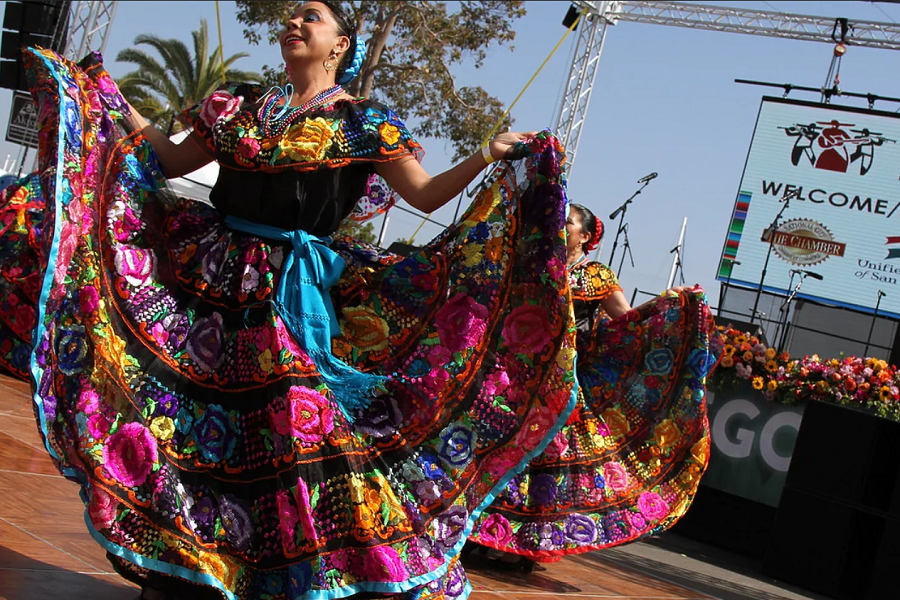Culture, color and traditions are combined every year to bring one of the most festive events in Mexico to the fore at the gala of Mexican bright mariachi…..
There are those who say that the very spirit of Mexico’s rich culture works hot in the veins of its mariachi, those musical icons that serenade the boulevards, public squares and sidewalks of the nation with the brand and style of music that is both unique and legendary.
Like the bullfighter, Mariachi is a symbol of nationalism and culture in Mexico, and there is great national pride in preserving the image of these singing heroes.
And there is no better place on earth to feel the sounds and colors of the mariachi tradition than at the International Mariachi Festival in Guadalajara, which is held every September, the largest mariachi festival in the world. The sights and sounds are simply unforgettable.

During the ten-day gala evening, Catholic masses are held, during which the mariachi perform in churches and cathedrals, numerous parades with hundreds of mariachi floats and folk ballet dancers are organized, rodeos are held, art exhibits are exhibited on every corner, and most importantly, the beautiful Benito Juárez Theater hosts the world’s largest mariachi competition. Only about 500 mariachi perform in various concert halls and street markets around the city, coming from far away, as from North and South America, Cuba, Spain and even Croatia, demonstrating the popularity and passion of mariachi music.
Fans can choose from dozens of different music events during the gathering, but many come for the unique opportunity to see the world’s best professional bands from Mexico and the United States, “los Mariachis VIPS”, which entertain throughout the week as special guests of the event. Their evening performances, played for the spacious crowd at the historic Degolado Theater, are lively, featuring star men’s and women’s backing bands and joint performances, often with the lavish accompaniment of the Jalisco Philharmonic Orchestra.
Festivalgoers can also view a mariachi art exhibition at the Regional Museum and take part in events at the headquarters of the Cabanas Cultural Institute, where numerous workshops are held, as well as a handicraft market for discerning mariachi musicians and their cultural cousins, the “Charro” or cowboys of western Mexico.
New additions to the festival program include train trips to the nearby and famous city of Tequila for tasting and lunch. The most notorious Mexican liqueur comes from a blue agave plant, and the area around Guadalajara is the dominant region for the fertile blue agave fields in Mexico.

Even one of the most famous opera stars in the world is prone to mariachi culture. Several years ago, the famous opera tenor Placido Domingo hosted the festival.
“I love Mariachi since I first came to Mexico from Spain as a child. When I was taking care of my wife, I hired mariachi singers to serenade her like lovers today. So how could I miss the chance to attend the greatest mariachi festival in the world?
Even if you have never had the pleasure to see or hear a mariachi performance in their home country, there is a chance that you saw them at big festive parades, concerts, theme parks or at a local Mexican restaurant. Mariachi and their style of music can now be found in all quadrants of the world, in places such as Japan and Europe.
MARIACHI HISTORY
Mariachi has evolved considerably since the Spanish arrived in Kokula in 1532. Traditional Mariachi got their inspiration from the time when peasant farmers had fun after hard work to harvest corn. It was not the hacienda owners’ preferred music, influenced by European styles of music, but Mariachi was the music of the people; rustic and folk, and to this day Mariachi music still has many original elements, such as the famous Mexican grito (scream).

Traditional mariachi originally included three instruments: the violin, the viela (five-stringed guitar) and the traditional six-stringed guitar. The groups that played them, as a rule, were quartets. Later, as the popularity of music increased, pipes and basses were added, as well as carefully designed and colorful costumes.
The Mariachi of the past wore traditional working clothes – white pants and shirt, straw hat and traveled in search of work. Hacienda owners hired them, and singing troubadours were paid more than the average worker to entertain owners and guests at parties and social events. Their songs embraced very deep and passionate souls of the Mexican people, from love and politics to death and revolutionary heroes. Mariachi songs always told true stories of the Mexican people.

With the revolution of 1810, many of the estates were forced to release the Mariachi. As they gained new independence from the Spanish aristocracy, they wandered from city to city, singing songs of revolutionary heroes and enemies, carrying news from one place to another, often being the only source of information about the ongoing struggle of the people of Mexico. Since they could no longer make a living playing in the rich estates, they turned to the hungry public for any price the locals could offer. One of the hot spots for this kind of public entertainment was San Pedro Tlacepake in Jalisco, a fashionable place for Guadalajara residents to spend the summer.
Since mariachi played for a fee, they had to add new elements to their music and expand their repertoire with waltzes and polka. It was then that new instruments were added and the costumes became quite luxurious.
The most valuable mariachi were still puppets from the state of Jalisco, especially from the regions of Kokula and Tecaltitlan.
